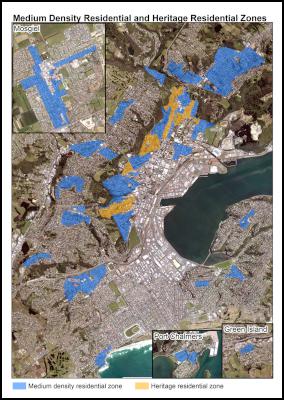Medium Density Housing Zones Identified

Click for big version.
Medium Density Housing Zones Identified
Dunedin (Tuesday, 21 October 2014) – The growth in one to two person households in Dunedin has prompted a rethink of how we look at residential development.
As part of the development of the Dunedin Spatial Plan and the city’s second generation District Plan (2GP), Dunedin City Council staff have been working with stakeholders and experts, and consulting with the community, to identify areas that should provide for medium density housing, particularly in areas close to centres, public transport, and community and recreational facilities.
Medium density relates to how many residential units there are per section. Medium density housing can be in the form of houses on small sections, semi-detached or terraced houses, or two to three storey apartment buildings on larger sections. Much of South Dunedin and the residential areas around the University of Otago are examples of areas that are developed to a “medium density” level.
DCC City Development Manager Dr Anna Johnson says various ideas about where to provide medium density housing have been tested through different stages of consultation. As a result of that feedback and further field work, a final set of areas to be included in the 2GP, to be notified in the first half of next year, has been proposed.
Many of these areas are already zoned for, or developed as, medium density housing, but some new areas have been identified to cater for a predicted growth in demand for different housing types.
From this week, owners and occupiers in areas of medium density zoning will be given a chance to see what is proposed in these areas and to provide feedback on the key draft Plan provisions.
Dr Johnson says the need to identify such areas reflects Dunedin’s changing demographics.
“The city’s largest demographic growth area is one to two person households, which includes couples with no children at home. These so-called empty nesters often want to make a move to warm, low maintenance forms of housing in their existing neighbourhoods. We need to ensure the city’s planning rules have scope to do that.”
The proposed medium density zones would require a minimum site size of 200m2 for subdivision. In terms of existing sites and newly-subdivided sites, 45m2 of land would be required for each ’habitable room’, which equates to a room that is, or could be, a bedroom. Providing all performance standards related to the building were met, this would allow, for example, a four bedroom house, or two semi-detached residential units with two bedrooms each, to be built on a 200m2 site.
Research by DCC planning staff and public submissions on the 2GP point to the need for medium density housing in areas where there is good access to public transport, community facilities and green spaces.
There are 23 areas that have been identified for medium density zoning. Five of these may need infrastructure upgrades if significantly more development occurred. The 23 areas include areas that are already zoned medium density, areas where development is at a higher level than is currently permitted and areas that might benefit from redevelopment to improve the range and quality of housing available. It also includes areas where there is a
market for more housing choices, where some change in housing types can occur without a major impact on existing amenity values.
Neighbourhoods already zoned for medium density (residential 2, 3 and 4) include areas below the Town Belt, around the University campus and parts of Caversham and Mosgiel. Areas where there is already quite a lot of medium density housing include parts of Mornington, City Rise, the Gardens area and North East Valley.
In some suburbs, such as Opoho, Roslyn, Belleknowes, Andersons Bay, Waverley and parts of Caversham, residential 1 zoning currently restricts building to a minimum 500m2 site, but there is a market for more housing choices.
“We believe medium density housing could be provided for, with appropriate design standards, in areas like these without significant impact on the amenity values of the area,” Dr Johnson says.
“Ultimately we want to spread the options for medium density housing across the city and not just be focusing on older areas that may be perceived as less desirable. We want people to have choices as they get older.
“Not everyone who wants to live in an apartment or low maintenance home wants to live in the central city. People want choices in their own neighbourhoods and there is a growing demand for quality smaller homes in our popular suburbs.”
In addition to the medium density housing zones, a further eight areas are proposed to be zoned as heritage residential zones, but with density and plan provisions similar to those for medium density zones.
From Wednesday, visit www.dunedin.govt.nz/2gp for more details and to fill out a survey on medium density housing. Consultation closes on Friday, 7 November.


 Gordon Campbell: On The Government’s Latest Ferries Scam
Gordon Campbell: On The Government’s Latest Ferries Scam RNZRSA: RNZRSA Supports Willie Apiata VC's Stand To Drive Change To Veterans’ Support Act
RNZRSA: RNZRSA Supports Willie Apiata VC's Stand To Drive Change To Veterans’ Support Act Diane McCarthy - LDR: War Hero Willie Apiata Entrusts MP With Victoria Cross Medal
Diane McCarthy - LDR: War Hero Willie Apiata Entrusts MP With Victoria Cross Medal PSA: Disappointing Govt Attack On Diversity, Inclusion In Public Service
PSA: Disappointing Govt Attack On Diversity, Inclusion In Public Service NZ Labour Party: Govt Health And Safety Changes Put Workers At Risk
NZ Labour Party: Govt Health And Safety Changes Put Workers At Risk Amnesty International Aotearoa New Zealand: Democracy At Risk
Amnesty International Aotearoa New Zealand: Democracy At Risk Walk Without Fear Trust: New Sentencing Reforms Aimed At Restoring Public Safety Welcomed
Walk Without Fear Trust: New Sentencing Reforms Aimed At Restoring Public Safety Welcomed


